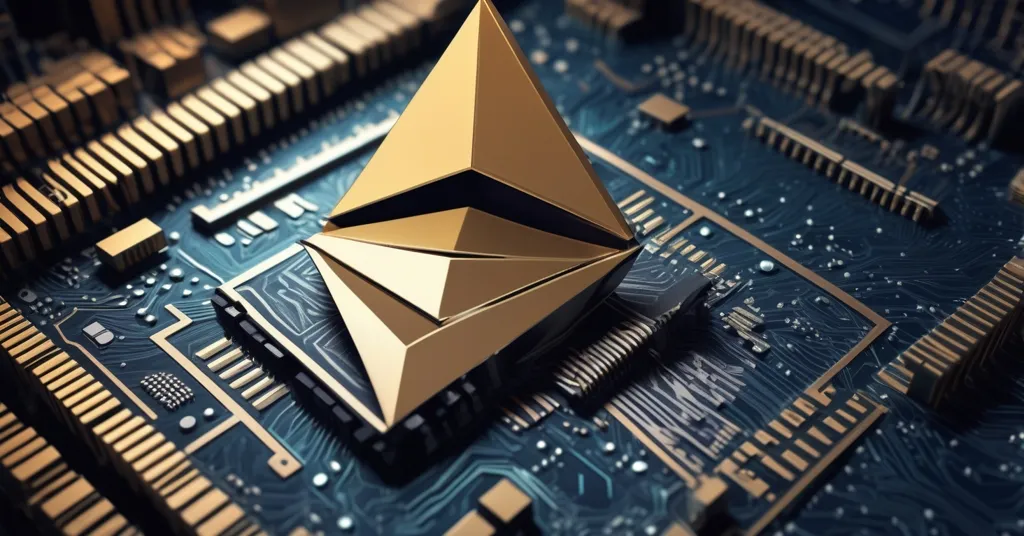Vitalik Buterin’s Bold Plan: Replace Ethereum’s EVM with RISC-V for 100x Efficiency

Vitalik Buterin Proposes Ethereum EVM Overhaul with RISC-V Integration
Vitalik Buterin, co-founder of Ethereum, has proposed a major upgrade to Ethereum’s core infrastructure by replacing the Ethereum Virtual Machine (EVM) with RISC-V, an open-source architecture. This ambitious move, shared on Ethereum’s core developer forum, aims to enhance scalability, lower transaction costs, and streamline the execution of smart contracts.
- Vitalik Buterin proposes replacing EVM with RISC-V
- Aims to improve scalability and reduce transaction costs
- Potential for up to 100x efficiency improvements
The EVM (Ethereum Virtual Machine), the engine that powers Ethereum’s smart contracts, has been both a boon and a bottleneck. While it has fostered a thriving ecosystem of decentralized applications (dApps), it has struggled with scalability and high transaction fees. Enter RISC-V, a freely available set of instructions known for its scalability and built-in encryption capabilities. Imagine if your transactions on Ethereum were 100 times faster. How would that change your use of the platform? Buterin’s proposal promises just that, suggesting that RISC-V could speed up the system by removing slowdowns and offering significant efficiency gains.
Buterin himself stated,
“Transitioning to a RISC-V-based execution layer could streamline Ethereum’s processing model, eliminating major performance bottlenecks and offering up to 100x efficiency improvements in certain use cases.”
This bold claim has set the Ethereum community abuzz, pondering whether this could be the key to unlocking Ethereum’s full potential.
One of the standout features of RISC-V is its native support for encryption. As Buterin noted,
“RISC-V’s native support for encryption could also serve as a less complex alternative to Ethereum’s ongoing efforts to integrate zero-knowledge cryptography into its execution layer.”
This could simplify the integration of advanced cryptographic techniques, potentially bolstering Ethereum’s security and privacy features. It’s like suggesting we swap out the engine of a moving car—exciting, but will it crash?
This proposal comes at a pivotal moment for Ethereum. The platform has been grappling with sluggish transaction volumes and ETH’s underperformance compared to other major cryptocurrencies. Additionally, the Ethereum Foundation recently underwent a leadership change aimed at providing clearer direction amidst concerns about Ethereum’s future. Buterin’s RISC-V proposal could be the catalyst needed to revitalize Ethereum and address these challenges head-on.
The potential benefits of RISC-V integration go beyond just performance improvements. By reducing transaction costs and boosting scalability, Ethereum could become more accessible to a wider audience, driving adoption and further solidifying its position in the decentralized ecosystem. The long-term vision for RISC-V integration is akin to other deep-layer projects like the Beam Chain, suggesting a fundamental shift in how Ethereum operates.
However, as with any major change, there are questions and concerns. How will the Ethereum community respond to this proposal? Will the transition to RISC-V be smooth, or will it face resistance from those invested in the current EVM? And what does this mean for Ethereum’s interoperability with other blockchains and Layer-2 solutions like Coinbase’s Base?
While the path forward may be uncertain, one thing is clear: Vitalik Buterin’s proposal has sparked a crucial conversation about Ethereum’s future. As the blockchain industry continues to evolve at breakneck speed, Ethereum must adapt and innovate to maintain its competitive edge. The RISC-V integration could be the key to unlocking a new era of efficiency, security, and adoption for Ethereum.
Bitcoin Maximalist Perspective
From a Bitcoin maximalist viewpoint, any upgrade to Ethereum that aims to improve its scalability and efficiency is a positive step towards pushing the boundaries of blockchain technology. However, Bitcoin maximalists might caution that Ethereum’s focus on smart contracts and complex applications could still detract from the core principles of decentralization and security that Bitcoin champions. They might argue that while RISC-V could enhance Ethereum’s technical capabilities, it’s crucial to ensure that these improvements don’t compromise the network’s integrity and security.
Effective Accelerationism
The RISC-V proposal aligns perfectly with the principles of effective accelerationism (e/acc), which emphasizes pushing the technological envelope to drive progress. By integrating RISC-V, Ethereum seeks to disrupt the status quo, accelerate technological development, and enhance the decentralized financial landscape. This move is a testament to the spirit of innovation and the drive to improve the blockchain ecosystem continuously.
Key Takeaways and Questions
- What is the proposed change to Ethereum’s infrastructure?
Vitalik Buterin proposes replacing the Ethereum Virtual Machine (EVM) with RISC-V, an open-source architecture.
- What are the potential benefits of integrating RISC-V into Ethereum?
The integration could offer up to 100x efficiency improvements, enhance encryption capabilities, reduce transaction costs, and improve scalability.
- How does RISC-V compare to the current EVM?
RISC-V is praised for its scalability and built-in encryption, potentially offering a more streamlined and efficient execution model compared to the EVM.
- What challenges is Ethereum currently facing?
Ethereum is dealing with sluggish transaction volumes, ETH’s underperformance, and concerns about its competitive position in the blockchain industry.
- What is the significance of the Ethereum Foundation’s recent leadership change?
The leadership change aims to provide clearer direction and address concerns about Ethereum’s future amid competitive pressures.
- How might the proposed change impact Ethereum’s position in the blockchain ecosystem?
If adopted, the shift to RISC-V could redefine Ethereum’s smart contract execution, improve interoperability, and help reestablish its technical edge in the blockchain landscape.



